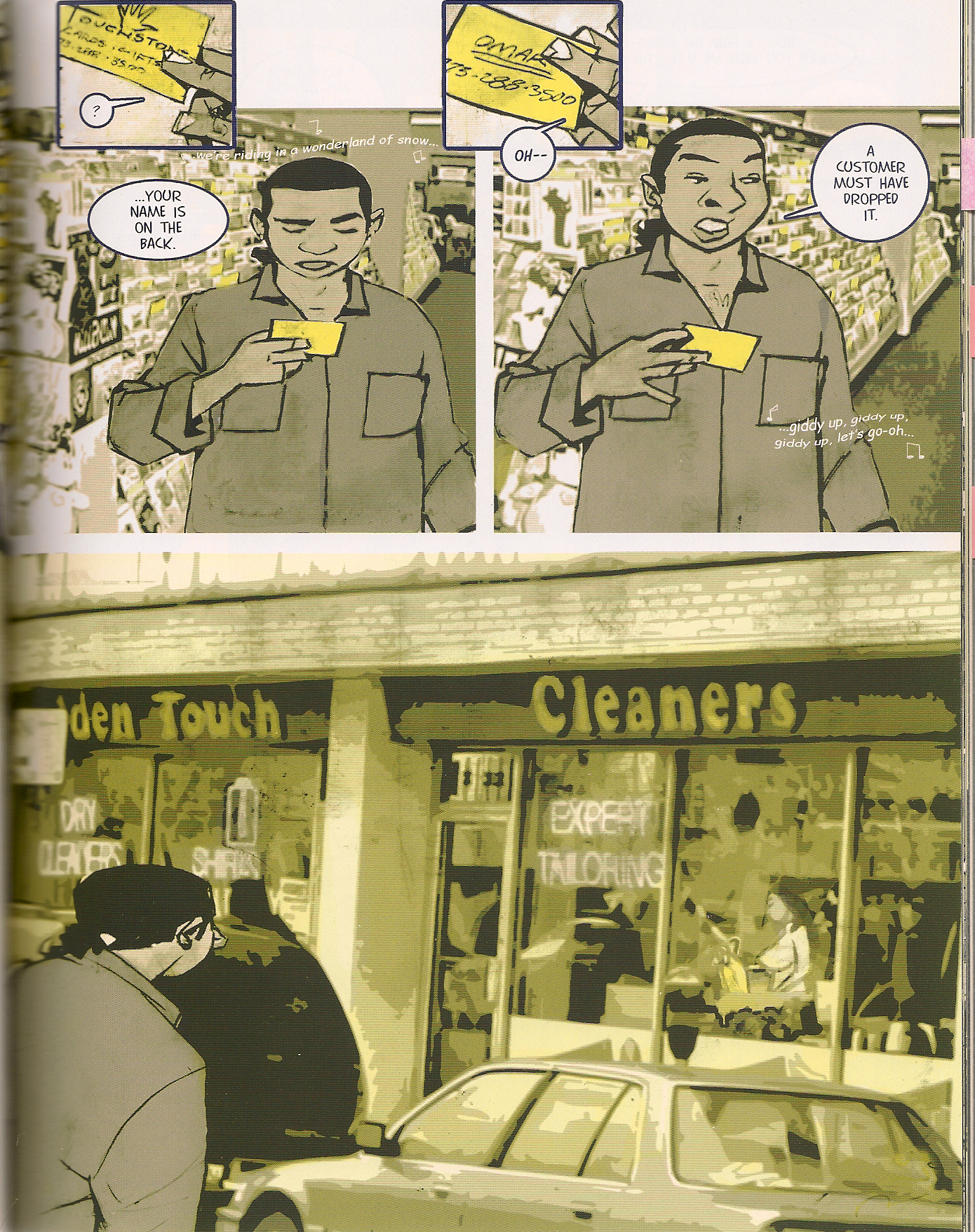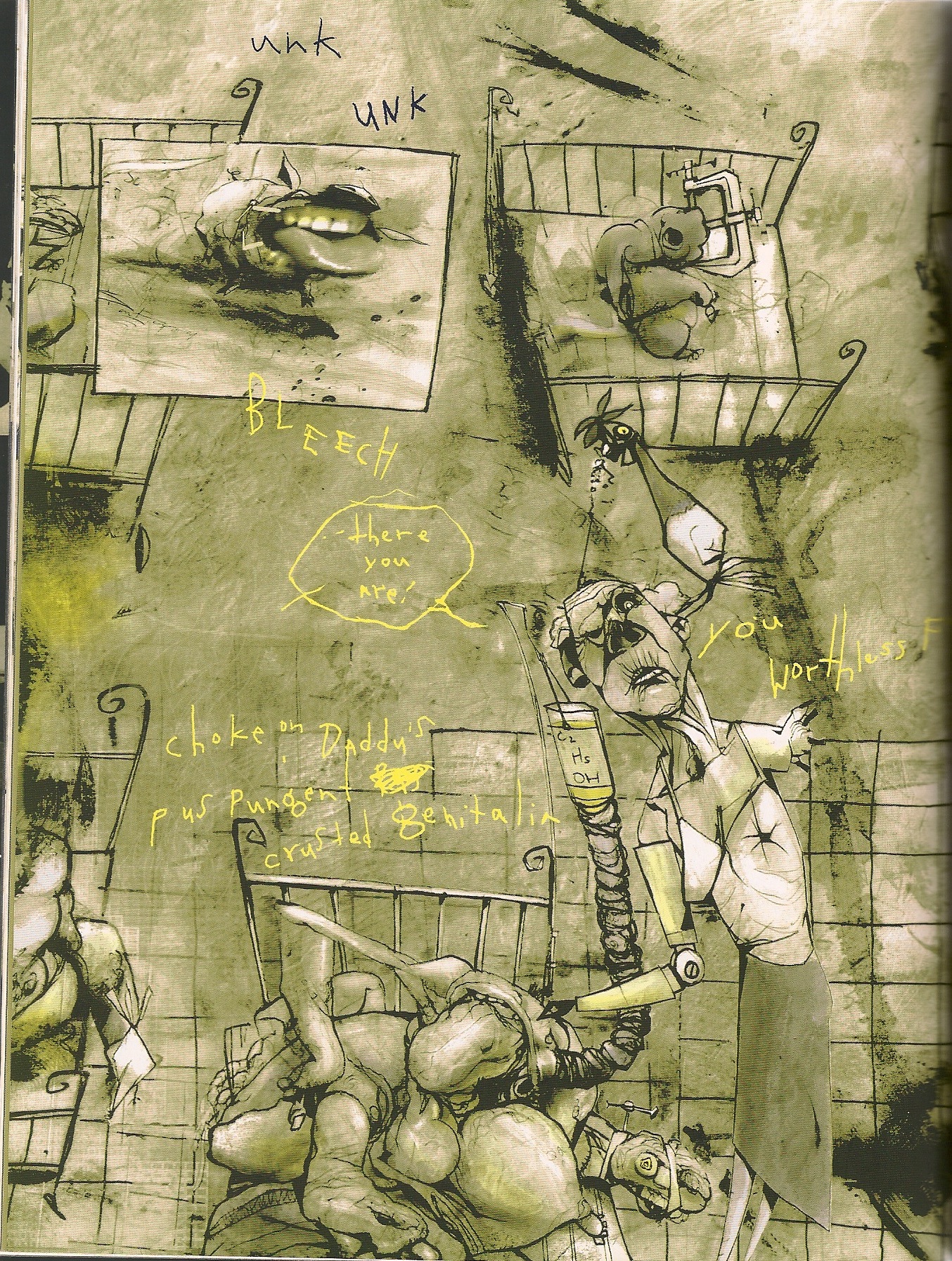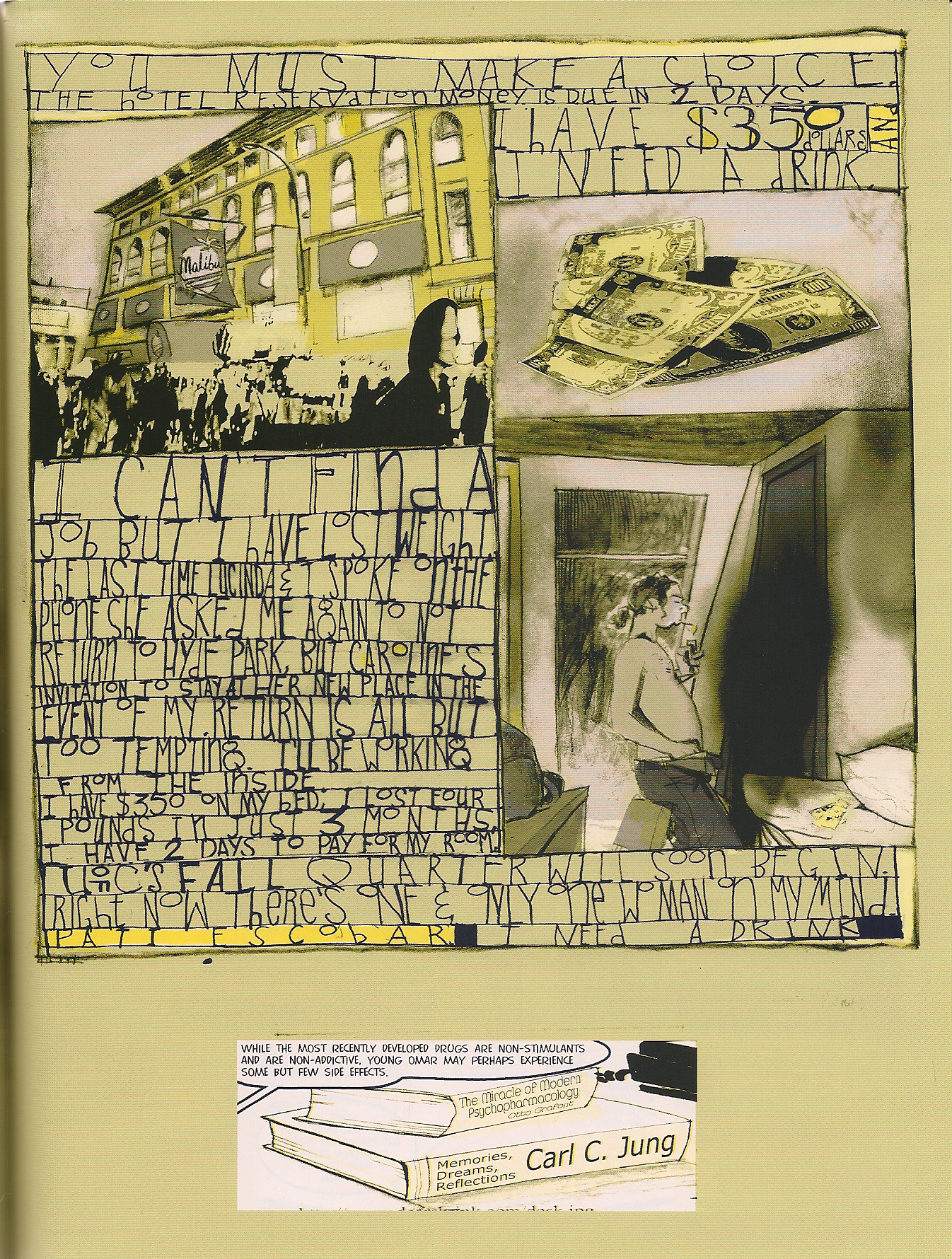I picked up Wilfred Santiago’s In My Darkest Hour (Fantagraphics, 2004) from the last-chance, all-sales-final, please-get-it-out-of-here longbox at my local comics shop. It was $4, and the lettering was interesting. I’m a fool for typography.
When I sat down to read it, I was turned off immediately. It is the decline-and-fall-and-get-back-up-again story of a rather repulsive young man named Omar — his horrible treatment of women and his attempt to get his life together. Toward the end of the book, we discover that he’s not a repulsive jerk, he’s mentally ill (or possibly both, but definitely mentally ill).
The visuals are impressive but frequently disturbing. Santiago describes himself as “Painter of Shadow™,” and he is indeed the anti-Thomas Kinkade. Mutilated women and distorted horrifying images of himself form the bulk of Omar’s hallucinations, visions, and insomniac fantasies, which are scattered among the diegetic scenes the way that Newsreels and Camera’s Eyes punctuate Dos Passos’ USA Trilogy.
And so I put it back down, thinking, “Oh, well, at least I’m not out a lot of money.” And it sat on my shelf, because I was too lazy busy to weed out unwanted comics.
Then, a couple of years later, I was scouring my shelves for new material to teach in a first-year seminar on comics, and I picked it up again. Knowing in advance that Omar was a demeaning, abusive jerkwad with delusions of horror, I could read it with new eyes – and I was blown away. Santiago does things with a page that few can match, taking advantage of almost all the possibilities of the form, and the narrative arc is subtle and fascinating as well.
Upon rereading In My Darkest Hour, I remembered another work that had offended me on first encounter, only to become a favorite: Jamaica Kincaid’s essay “In History,” in which she considers botanical nomenclature, colonialism, and the triangularity of the Middle Passage, all in a format that is radically ungrammatical. It too I had picked up, thrown down forcefully, picked up again, and embraced. And in both cases, my offendedness (re the treatment of women and re the treatment of the English language, respectively) blinded me to the splendors of the work.
I love a surprise ending, and in my dreams, you will think, “Well, if Meg likes it, I’ll run right out and read it,” but the world doesn’t work like that. So here are some of my favorite images:
I include this one not only as a sample of Santiago’s basic diegesis but also for the way he foregrounds and backgrounds the action. I particularly admire the final panel on this page and the way that it uses human pigmentation metaphorically (i.e., not to demarcate the Cambodian, the Japanese, and the Caucasian in the scene.)
Here is an example of Santiago’s ekphrastic use of geography. You could sketch out the environs of the University of Chicago using his locational references, which are straight photographs in some scenes, heavily-manipulated photos in others, and pure drawings in yet others.
Obviously, this is one of Omar’s hallucinations. Santiago deploys different techniques for different interludes of derangement, sometimes making use of the background surface as he does here. I continue to marvel at the way that this image pushes buttons of dread that I didn’t know I had. I particularly like the photographed human tongue in the dog’s mouth in the upper-right inset.
Here Santiago reveals his influences more clearly than usually, particularly Ralph Steadman, Alan E. Cober, and in the calligraphy, someone whom I can’t recall for the life of me. The juxtaposition of the tinted main scene, with its interplay of images and written voice, and the bright white memory of the doctor’s office is what I consider a signature Santiago touch.
Finally, I include this image as an example of the exegetical demands that Santiago makes of the reader, particularly with his page architecture.
I confessed my love of surprise endings, and In My Darkest Hour has one – but it only appeared to me after several readings, resolving itself like the Magic 8 Ball prophesy gradually appearing through the murk. Far be it from me to give it away, but pay close attention to the different lettering styles, physical traits and objects, and the way that color structures the narrative.
___________________________________________________________________________________________
Let this be a lesson to you, as it was to me: If you find yourself offended (as opposed to bored or unimpressed) don’t break off contact but examine your objections. It’s a standard teaching ploy to force students to articulate why they didn’t like something, and I regularly need a dose of my own medicine. It’s particularly important for us to do this in cases where the offending material is in the voice of the Other, which may violate our formal conventions and literary/artistic expectations not out of ignorance or disregard but for strategic reasons.
In My Darkest Hour and “In History” are now frequent guest stars in my syllabi, but I know better than to assign them without comment. It makes all the difference (and I learned this the hard way) to tell the class that In My Darkest Hour is one of my favorite comics of all time but that I hated it on first reading. They are free to hate it, I tell the students, but they must at a minimum come back to class with a theory about why I came to love the book. So far, formulating this hypothesis has converted every hater.
Since I’ve already invoked conversion, I’ll end on a missionary note. Go get yourself a copy of In My Darkest Hour, by hook or by crook, and spend an afternoon with it. See what amazing things Wilfred Santiago can do with color, lettering, illustration, photography, dialog, geography, and narrative. And while you’re at it, read Jamaica Kincaid’s essay too.
Me, I’ll be daydreaming about a Wilfred Santiago graphic novel version of “In History.”





